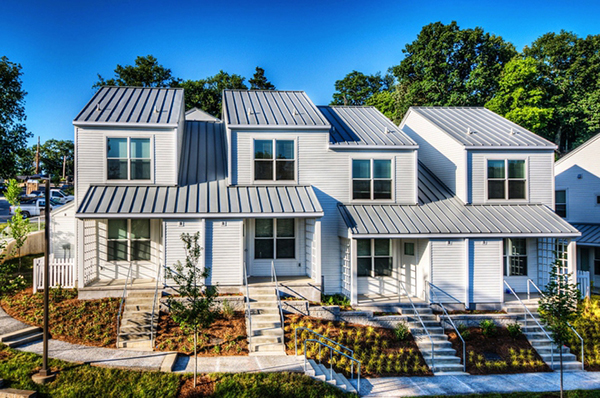
Hefferlin + Kronenberg Architects have completed a project in Chattanooga, Tennessee called the Fairmont Avenue Townhomes. The townhouses were designed to provide sustainable, low-income homes for the Chattanooga housing authority. The project was funded by HUD following a nationwide competition between housing authorities. The Fairmont Avenue Townhomes project was also designed to comply with Enterprise Green Communities Criteria and is applying for LEED Platinum for Homes certification.
The Fairmont Avenue Townhomes project consists of 18 units, half of which are 3-bedroom, 1383 square foot homes. The other half of the units are two-bedroom homes measuring 1103 square feet. All the units, except the single FHA accessible unit, are two-story homes, and are organized in buildings made up of four units. The townhouses are well connected to the local amenities and the surrounding pedestrian circulation system by three all-weather pathways.

Unfortunately, a large hill to the south of the building site prevented the builders from placing solar panels on the roofs of several of the units. In the end, the designers used 189 photovoltaic solar panels, which are able to provide about 10% of all the power needed to operate the eighteen units. The power collected by these solar panels is sold back to TVA by the Chattanooga Housing Authority and becomes part of TVA’s Green Power Program. On site, the buildings were also placed in such a way as to take the greatest possible advantage of passive solar heating and cooling, as well as to maximize the available open space.

The roofing selected for the project is a high albedo, standing seam metal roof, which has 25% of recycled content. One of the main reasons they chose a metal roof and not a shingle roof is to extend the durability of the buildings, since metal roofs have a longer lifespan. The roofs are colored light grey which works to deflect heat from the sun away from the homes rather than entrapping it. This means that the HVAC of the units functions more efficiently and contributes to the reduction of Chattanooga’s heat island effect.

In addition, rainwater is collected from the metal roof and stored in a cistern that is then used by the sprinkler system to water the native plants that were used in the landscaping.
This project goes a long way to prove that affordable housing does not need to be cheaply built, and that sustainable living is quite possible even if its being done on a budget.
Related Articles on JetsonGreen.com:
Sustainable and Affordable Housing Built in Santa Monica
Student Housing Built From Shipping Containers
Old School Transformed Into a LEED Platinum Affordable Housing Complex

Leave a Reply
You must be logged in to post a comment.